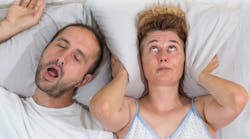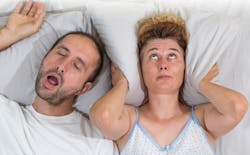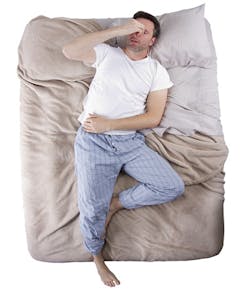Troubled Sleep: The advantages of treating sleep apnea with orofacial myofunctional therapy
By Timbrey Lind, RDH, OMT, and Shirley Gutkowski, RDH, BSDH, OMT
"I'd use my sleep apnea machine, but it comes with a big mask that you have to put over your face, and it's not too sexy," my patient said during his appointment. Do you know what my response was? "Snoring isn't so sexy either." The American Sleep Apnea Association states that about 90 million people snore. Not all suffer from obstructive sleep apnea.
We want to help people, and that's what we do each time we see a patient. We prevent oral cancer by performing screenings and detecting tissue changes at the earliest stages. We prevent heart attacks by checking blood pressure on each patient. Can we prevent a poor quality of life and even death by asking a patient how they are sleeping at night? Some of us do, and some of us don't. We all should.
Sleep apnea is far more common than we think, because most of the time it goes undiagnosed. According to the National Sleep Foundation, "more than 18 million people have sleep apnea." This figure does not include pediatric sleep apnea. Sleep apnea can affect a person at any age. In other words, it affects anyone. In fact, we all know at least one person close to us who suffers from sleep apnea. Maybe you even have some sleep disrupted breathing (SDB) issues. A lot of times this can be overlooked because not all fit the classic description of overweight, high BMI, and a neck circumference greater than 17 inches.
For example, both of Timbrey's parents and her sister suffer from sleep apnea. Besides the dark circles under their eyes, their complaints of daytime sleepiness, and the constant loss of focus, they snore and have been witnessed to stop breathing while snoring.
Let's talk about what sleep apnea is and the different types there are, as well as how orofacial myofunctional therapy can help, before looking at more "traditional" treatments.
WebMD provides a pretty good definition of sleep apnea as "... a serious sleep disorder that occurs when a person's breathing is interrupted during sleep. People with untreated sleep apnea stop breathing repeatedly during their sleep, sometimes hundreds of times. This means the brain-and the rest of the body-may not get enough oxygen."
May not get enough oxygen? Isn't that how comas happen?
Recognizing Sleep Apnea
From an anatomical perspective, the oropharynx is the part of the body that includes the mouth and throat. In simple terms, the oropharynx is a tube lined by muscular tissues. These muscles help us to eat, talk, and breathe. They also help to keep the airway open, especially during sleep.
When the muscles of the oropharynx are weak, they disrupt the flow of air, and that is when snoring happens. If the tube collapses, the airway becomes blocked, such as what happens during sleep apnea. Moreover, a weak and floppy tongue may fall back into the throat and create an obstruction.
An orofacial myofunctional therapist can help manage those muscles. Sleep apnea is categorized into two different types: obstructive sleep apnea (OSA) and central sleep apnea (CSA). Central sleep apnea is caused when the brain fails to signal the muscles to breathe. It's pretty serious, and orofacial myofunctional therapy is limited in effectively treating it.
On the other hand, obstructive sleep apnea is far more common. It's caused by a blockage in the throat (which is usually the soft tissue, namely the soft palate) while sleeping. Orofacial myofunctional therapy can help this kind of sleep apnea by working with the muscles of the oropharyngeal complex, although the therapy is considered adjunctive.
One more category should be added to this discussion. This category is often missed, because it doesn't "qualify" as a type of sleep apnea. Yet, an uncounted number of people are affected by it. Upper airway resistance syndrome (UARS) is a type of sleep disorder that is characterized by resistance of the airway while sleeping. It's similar to OSA in the sense that there's abnormal airway blockage or resistance, but it doesn't get to the point where the airway is totally obstructed.
UARS is underdiagnosed because it doesn't show up as a problem on a classical sleep study while examining the apnea/hypopnea index (AHI). UARS may be caused by allergies or structural conditions such as small maxillae.
Home Sleep Studies
Let's walk through a home sleep study. Many important things are recorded during a sleep study-for example, eye movement, heart rhythms, breathing patterns, and brain activity. The most important recording is the oxygen desaturation index (ODI). Oxygen saturation is the percentage of oxygen that is in our blood. So we pay attention to how much the ODI drops when someone is sleeping.
When someone has obstructive sleep apnea, their oxygen saturation levels drop every time they stop breathing, which in turn makes the heart work harder trying to get oxygen to the cells.
Two other major indexes are the apnea/hypopnea index (AHI) and the respiratory disturbance index (RDI). AHI measures the apneic events in an episode of fully occluded breathing that lasts 10 seconds or more, and a hypopnea event is an episode of partial occlusion. The respiratory disturbances measured are called RERAs (respiratory effort related arousals), which is a short arousal that follows partial occlusion of the airway. In a 2012 article in SLEEP, Krakow studied over 500 awakenings and found 90% were preceded by sleep breathing events. The patients didn't know they had a sleep breathing event before they woke up. They thought they had a nightmare, had to go to the bathroom, or had some kind of pain.
When patients present with high RDI results, it's labeled as an upper airway resistance syndrome. Researchers have reported lately that, although these patients don't qualify as having obstructive sleep apnea, there was a reason the RDIs were coming back so high. They found that the patient was receiving enough oxygen, but struggling to do so.
This is a chance to treat early on, before the patient falls into the category of obstructive sleep apnea. A majority of patients fall into this category, especially women in the 30-55 age range. Christian Guilleminault wrote a study titled "Upper Airway Resistance Syndrome (UARS): A Common Cause of CFS and Fibromyalgia." Those with OMT training can help people with UARS to find out early what is best for the patient. Once obstructive sleep apnea is diagnosed, the job becomes a little more difficult.
Treating Sleep Disorders
Now that we know a little bit about the different types of sleep disorders and which are appropriate for OMT referrals, let's look into how they are treated.
It is always a good idea to have two referrals for your patients: a sleep doctor and airway focused dentist. In most states, dentists are not allowed to interpret sleep studies, so a sleep physician is good to have on your team. The sleep doctor is important in order to get the sleep readings, and it is always a good idea to get a full PSG (polysomnogram) for patients you suspect as having obstructive sleep apnea. Also, referrals to an airway focused dentist can lead to oral sleep appliances, as well as a closer look into why patients are struggling with sleep apnea in the first place.
Sleep appliances alone, or in conjunction with orofacial myofunctional therapy, are a widely used and very effective way to treat sleep disorders. Mandibular advancement devices (MAD) are especially helpful in patients with mild to moderate range disorders such as UARS. Dental appliances are also good for treatment in conjunction with a CPAP (continuous positive air pressure).
Many patients are "CPAP intolerant," which means they cannot stand wearing the CPAP. Even the American Sleep Apnea Association confirms, "the actual usage of CPAP is only approximately 50 percent of the time." Luckily, the masks of CPAPs have changed and evolved into smaller and more comfortable devices.
In recent news, former U.S. Supreme Court Justice Antonin Scalia died in his sleep, but his CPAP was on the bedside table unplugged and unused.
Worst-case scenario, surgery is always an option; some options include nasal surgery, UPPP (uvulopalatopharyngoplasty), and tongue advancement, to name a few. I have had patients go through surgical options with mixed results. I haven't had one patient, though, who has experienced great results from any surgery. Patients suffer loss of time and function for these surgeries, and many times patients are not satisfied with the results. Plus, there's no turning back. There are no soft palate donors for those who want the procedure reversed.
The last form of treatment to mention is orofacial myofunctional therapy. In 2015, a meta analysis of CPAP compared to myofunctional therapy concluded: "Current literature demonstrates that myofunctional therapy decreases apnea-hypopnea index by approximately 50% in adults and 62% in children. Lowest oxygen saturations, snoring, and sleepiness outcomes improve in adults. Myofunctional therapy could serve as an adjunct to other obstructive sleep apnea treatments."
We think that is a huge percentage, and this is all from oral and facial muscle retraining. Pretty amazing!
My ofunctional therapy
Myofunctional therapy is a series of exercises that not only strengthen, but repattern oropharyngeal muscles and their use. The exercise sequence is sometimes called rehabituation. OMT teaches people how to break old habits and create new ones. Habits that will last a lifetime require adjustments, so the therapy may take a while.
Dr. Leslie Gonzalez Rothi, a professor of neurology at the University of Florida, said it best when she wrote, "The focus of these approaches is on the replacement of knowledge through the act of doing the desired behavior. Additionally, the idea is to do it intensively and avoid behaviors that serve to compensate for or are in lieu of the desired behavior."
Dr. Gonzalez Rothi is referring to actual neurorehabilitation (retraining the brain) when doing these exercises.
The therapist notes that muscle weakness contributes to sleep apnea. Strengthening those muscles through myofunctional therapy helps improve breathing, sleeping, snoring, eating, swallowing, talking, etc. To give you an idea of how this is done, get a glass of water. Adjust your posture and take a little sip of water, open your mouth, and swallow with your mouth open, making sure your head doesn't move when you swallow. Can you do it? This is an example of strengthening of the back of the tongue and muscles of the soft palate. By learning to control and strengthen our muscles, the muscles are able to work more synergistically with one another, and it also opens the airway, providing more space for better breathing and airflow.
Another positive of the OSA treatment is that it is noninvasive. Patients need to make a daily time commitment for myofunctional therapy. The appointments are convenient and can be taught at home, in a therapist's office, or even using telemedicine via Skype, Facebook, Google Hangouts, or Facetime. The exercises can be performed by patients in their cars on the way to work, washing dishes, or during a Hulu binge.
For dental hygienists who work in pediatric offices or treat children within the general dental practice, it is equally, if not more important, to look for signs of sleep disordered breathing in children. In another study from Christian Guilleminault, he examined pediatric sleep disordered breathing and came to this conclusion: "...despite short-term improvements after T&A (tonsil and adenoid removal), continued use of the oral breathing route (mouth breathing), will be associated with abnormal impacts on airway growth and possibly blunted neuromuscular responsiveness of airway tissues, both of which may predispose to the eventual return of upper airway collapse in later childhood, or in the full-blown syndrome of OSA in adulthood."
As CPAPs become more widely used and known, many people will not even consider an appointment for their sleep issues because they imagine life with an elephant's trunk on their face. They do not want to have to make the decision about wearing the CPAP or not.
That's why OMT is so important. While not a cure or definitive treatment, OMT can make breathing easier. We realize how serious obstructive sleep apnea is. If we have the chance to prevent it from an early point in one's life, why wouldn't we? After all, we are in this prevention profession to help people and make a difference, right?
Timbrey Lind, RDH, OMT, is a practicing dental hygienist with a holistic approach to care. Specializing in orofacial myofunctional therapy, her passions are working with infants and children. Her practice, The Connection, is based in Agoura Hills, California.
Shirley Gutkowski, RDH, BSDH, is a practicing dental hygienist specializing in orofacial myofunctional therapy. Her practice, Primal Air, LLC, is in Sun Prairie, Wisconsin. Ms. Gutkowski is also the host of Cross Link Radio, a podcast with timely information integrating oral and systemic health.








